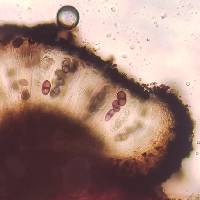
- Home
- Search
- Images
- Species Checklists
- US States: O-Z >
- US National Parks
- Central America
- South America
- US National Parks
- Southern Subpolar Region
|
|
|
|
Family: Caliciaceae
[Buellia langloisii Imshaug] |
MB#464832 TYPE. UNITED STATES. FLORIDA, [Seminole County] Sanford, on old tree trunk, February 1918, S. Rapp 619 (FH 00388427, holotype). Description. Lichenized fungus. Thallus crustose, continuous, thin, pale yellowish brown; vegetative diaspores absent; hypothallus absent.Photobiont chlorococcoid alga. Ascomata lecideine apothecia, adnate, 0.3-0.7 mm diam.; disk black, plane; margin black, +/- raised, persistent. Exciple melanized exteriorly, paler interiorly; epithecium dark with brown-capped paraphysal tips; hymenium hyaline, not inspersed, 90-120 µm; hypothecium reddish brown, extending into the thallus as a stipe. Asci narrowly clavate, 8-spored. Ascospores brown, 2-celled, ovoid-ellipsoid, not constricted at septum, 14-20 x 8-11 µm; spore walls thin uniform, outer wall strongly ridged. Pycnidia not reported; conidia filiform, 15-35 µm. Chemistry. Thallus K+ yellowish, PD-; hymenium I+ deep blue; lichen substances not detected by TLC. Substrate and Habitat. Corticolous on hardwoods and Sabal palms. Distribution. Southeastern North America along the Gulf and Atlantic coasts; in North Carolina found along the coast. Notes. This taxon was first described as Buellia langloisii by Imshaug (1951) in his Ph.D. dissertation, and not formally published. Marbach (2000) placed the species under the genus Amandinea, thereby formally publishing the taxon. Literature Giralt, M., P. Van den Boom & J. Elix. (2015). Amandinea lobarica, a new corticolous species from Guatemala, with notes on some additional Amandinea taxa. The Lichenologist 47(4): 257-268. Imshaug, H.A. (1951) The Lichen-forming Species of the Genus Buellia in the United States and Canada. [Ph.D. dissertation] University Microfilms. Ann Arbor, Michigan. Publication No. 2607. vi + 217 pp (original description as Buellia langloisii). Marbach, B. (2000) Corticole und lignicole Arten der Flechtengattung Buellia sensu lato in den Subtropen und Tropen. Bibliotheca Lichenologica 74: 1-384. |















































































